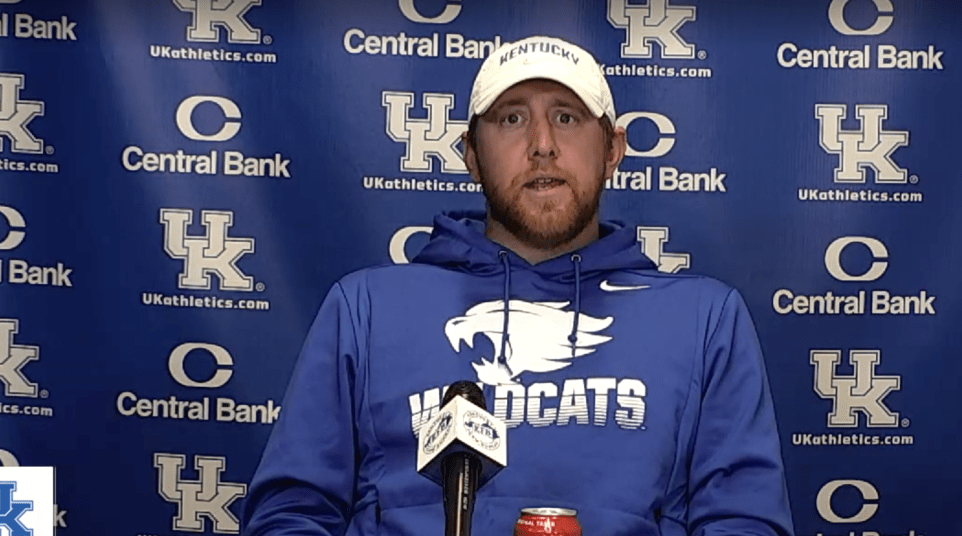
What’s the (realistic) ceiling for Kentucky’s offense?
It wasn’t exactly a secret why Kentucky made a move at offensive coordinator from ground and pound Eddie Gran to NFL passing apprentice Liam Coen. While Kentucky’s defense has led UK to 5 straight bowl appearances and 3 straight bowl wins, Kentucky’s offense has been, well, downright offensive at times. Finishing last in the SEC in passing in each of the past 2 seasons didn’t do much to help the Wildcats. But with the transition made, how good can this Kentucky offense be? Taking out possibilities like UK suddenly turning into LSU circa 2019, here’s a realistic projection.
How much more passing?
First, the obvious. Kentucky will pass more — and better. After finishing 14th in the SEC in passing in 2019 (114 yards per game) and 2020 (121 yards per game), the Wildcats will definitely show better returns in 2021. But how much better? Well, Mike Hartline in 2010 was the last Wildcat to pass for 3,000 yards in a season. But more immediately, the highwater mark of the passing game in Mark Stoops’ tenure at UK was 2014, when Patrick Towles and the Wildcats passed for 231 yards per game. Of the starting QBs Stoops has managed in Lexington, Towles is probably the most similar to Levis. Given that he passed for over 2,700 yards in 2014 with Ryan Timmons and Demarco Robinson as his main receiving weapons, it’s reasonable to expect Levis to make similar strides with Wan’Dale Robinson and Josh Ali.
Projecting a 13th game for UK in 2021, if Levis stays healthy, he reasonably should be Stoops’ first 3,000-yard passer. For Kentucky to double this 2020 passing results — 242 yards per game — is a goal that is both significant and reachable. Anything more would be gravy.
How does it affect the ground game?
For all the bad things to say about the passing game, Kentucky has ground defenses to shreds with their rushing attack. Not since 2013, Stoops’ first year, has Kentucky failed to average over 4 yards per carry — and in 3 of the past 5 seasons, the Wildcats have managed 5 yards per carry or higher. Play-calling is something of a zero-sum game. If you call 50% more passes, you have to call fewer runs. But how many fewer? And to what impact?
Last season, Kentucky averaged 39 rushes and 22 pass attempts per game. If the passing totals increase to, say, 34 attempts per game (that was the 2014 average), then does that mean a dozen fewer rushes? Well, no. Passes stop the clock more than runs, and Kentucky’s more aggressive offense will probably average more than 61 plays per game in 2021. Let’s say UK manages 34 rushing attempts, for a perfect 50/50 offensive balance. Only 5 fewer rushes per game should help the Big Blue Wall maintain its consistency, and shouldn’t have a big impact on the rushing totals. Given that Levis’ passing threat should loosen up defenders out of the box, if Kentucky improves from, say, 5.0 yards per carry to 5.3, which seems plausible, that would be a difference of about 15 rushing yards per game, taking Kentucky down to around 180, which would still be comfortably in the top half of the SEC, maybe even the top third. Add in better red-zone production and the impact should be minimal.
Points on the board?
Ultimately, as long as the score is kept, points will be the ultimate measuring stick of an offense. Stoops’ top offensive total is exactly 30 points per game for the 2016 team that was his first group to make a bowl. Granted, that team had a sieve of a defense that allowed 31.3 points per game, while Kentucky’s last three defenses have given up 17, 19, and 26 points per game. What can Coen’s offense deliver?
Well, the estimates of 242 passing yards and 180 rushing yards per game would have placed Kentucky 6th in the SEC in total offense last year (the Wildcats actually finished 14th). A similar finish in scoring would have ended up with UK at 31-32 points per game. That also sounds reasonable. And a season with UK setting new highs for Stoops’s teams in points and passing yardage is likely to make for a very happy fall for Big Blue Nation.
